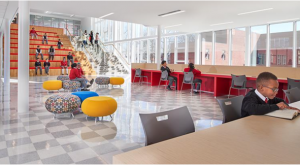Facility Advocacy Efforts Win Over $100 Million for Charter Schools
This year, advocates across the country secured critical funding and regulatory changes at the state level to improve the charter school facility landscape. These efforts brought over $100 million in public funds to help offset the costs of charter school facilities.
Check out these eleven states where we saw positive legislation for charter schools and facilities:
- Colorado – Legislators increased the cap on moral obligation bonds for charter schools from $500-750 million. The State Treasurer announced the moral obligation program has already saved charter schools over $100 million in interest payments. The increase in the moral obligation program should result in significantly more savings.
- Florida – New charter schools authorized by a state university or Florida College System institution are now eligible for funds from each school district’s current operating discretionary millage levy. This can provide more equitable funding for facilities by accessing some of the same facility funding tax base that the district uses.
- Georgia – Legislators increased state funding for district-authorized charter schools and ensured districts allocate a proportionate share of federal funding to district-authorized charter schools. These funds have the same eligible uses, including facility expenses.
- Indiana – The state increased its per-pupil charter school facilities allotment from $500 to $1,000 per-pupil in the first year of the budget and $1,250 per-pupil in the second year.
- Nevada – The legislative session ended with a big win for Silver State students. Not only did the legislature protect operations funding for Nevada's successful charter school sector, they also provided $15 million in COVID relief funding to Title I charter schools, which serve many of the state's underserved students and families. This dedicated funding can support unique learning opportunities and be used for facilities to support the teachers and leaders that serve more than 16,000 students from low-income backgrounds.
- New Jersey- For the first time ever, NJ charter schools will receive facilities aid now that $5 million of charter schools facilities improvement funding has been signed into law as part of the Governor's FY22 budget.
- New Hampshire – The legislature passed a bill that would provide charter schools the right of first refusal to acquire or lease excess school district space. Additionally, the state increased the amount of lease aid from $30,000 to $50,000 per year to help offset the cost of a facility lease.
- Ohio-The state doubled its per-pupil charter school facilites allotment from $250 to $500 per-pupil. They also modified the definition of unused facilities to help charter schools access more unused district buildings.
- Oklahoma – A bill passed that will provide charter schools with additional funding for facilities with access to the Building Equalization Fund. This could result in $350 per student each year starting next year. The legislators themselves will deliver the checks to the schools and hopefully meet parents, teachers, and students. Have your cameras ready!
- Tennessee – The state legislature passed a budget that included $6 million in recurring funding and $18 million in non-recurring funds for charter school facilities, totaling $24 million for charter school facilities.
- Texas – House Bill 3610 recently passed to remedy scenarios in which charter schools must pay property taxes on purchased or leased property. The legislation amends the Texas Education Code to classify open-enrollment charter schools as political subdivisions for the purposes of exempting from property taxation any public property “purchased, leased, constructed, renovated, or improved with state funds after September 1, 2001.” Rep. Dan Huberty (R-Houston) said the Supreme Court had ruled that buildings owned by public schools or businesses but used for a “public purpose” could be exempt from property taxes. Huberty also pointed out that as public schools, charter schools were using state education funds to pay the property taxes.
Thanks to all of the state advocacy groups and their financial supporters!
After this year, we expect to see more organizations realize the benefit of advocacy and increase their support for this important role in helping charters thrive in a friendlier environment. We also know the opposition will increase their efforts to hamper the growth of charter schools by denying them facilities.
We hope to see many other states pursue facility-related legislation in the next session as well.


